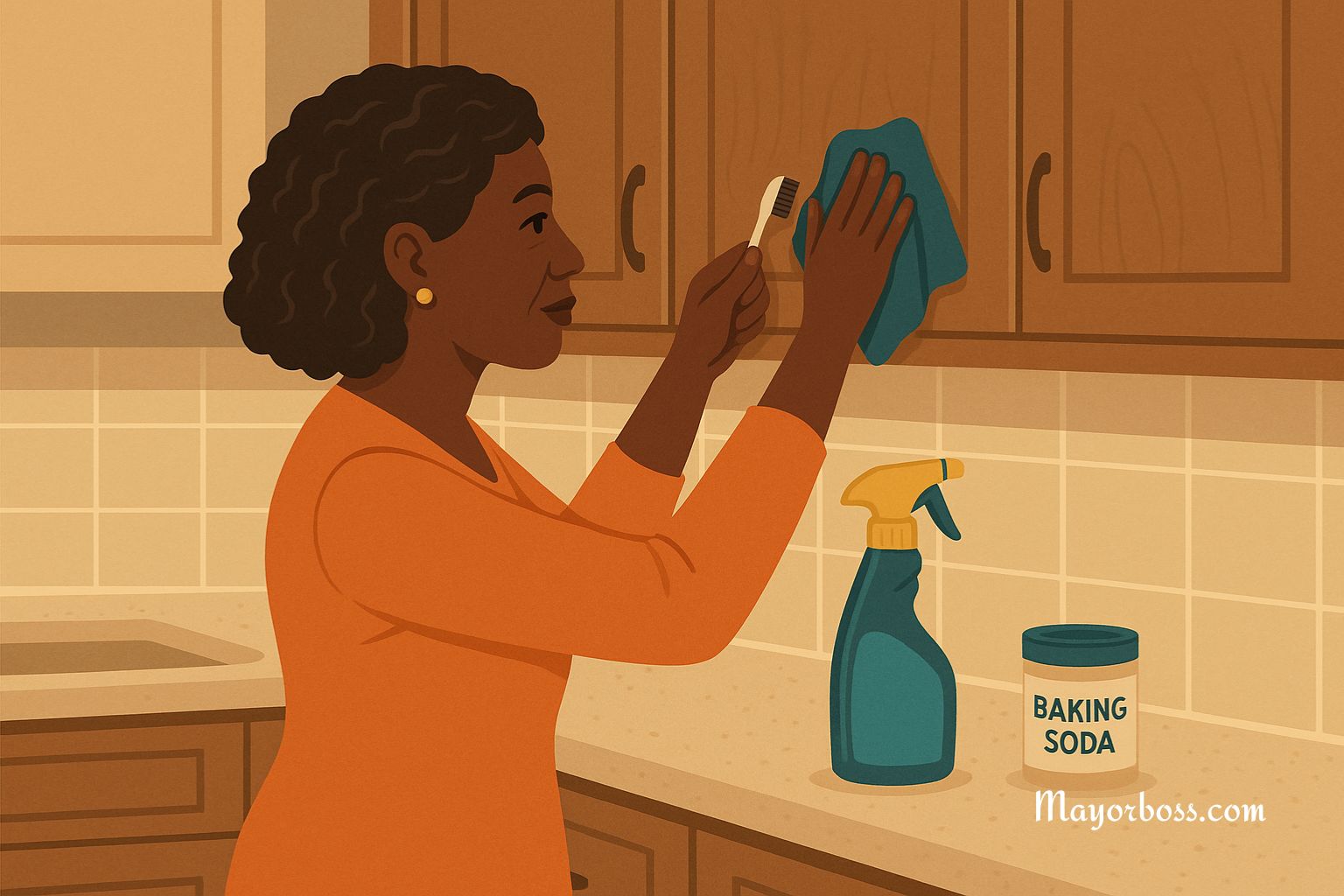Easy Cleaning Hack: How to Remove Grease from Cabinets
Greasy kitchen cabinets are a common problem, especially around the stove. Over time, cooking oils and food particles stick to cabinet surfaces, forming a thick, sticky film. If not cleaned regularly, this buildup becomes harder to remove. But the good news? You don’t need harsh chemicals or hours of scrubbing to get your cabinets looking clean again.
This article will show you a simple, effective method to remove grease from your cabinets using ingredients you probably already have at home.
Sounds good? Here we go!

Why Grease Builds Up on Cabinets
Every time you cook—especially when frying or sautéing—tiny droplets of oil float into the air. These droplets settle on nearby surfaces, including your cabinets. Over time, they mix with dust and food particles, creating a sticky residue. Grease is stubborn. Water alone won’t break it down, which is why you need a solution that cuts through oils effectively.
What You’ll Need
You can clean greasy cabinets with just a few basic items:
- Warm water
- White vinegar
- Dish soap (like Dawn)
- Baking soda (optional for tough spots)
- Spray bottle
- Microfiber cloth or sponge
- Old toothbrush (for corners and grooves)
Step-by-Step: How to Clean Greasy Cabinets
Step 1: Make the Cleaning Solution
Mix equal parts white vinegar and warm water in a spray bottle. Add a few drops of dish soap. Shake gently to combine. Vinegar cuts through grease, and dish soap helps lift it from the surface.
Tip: Use warm (not hot) water. Warm water helps loosen the grease but won’t damage cabinet finishes.
Step 2: Spray and Wipe
Spray the solution directly onto the greasy areas. Let it sit for 2 to 3 minutes. This gives the cleaner time to break down the oil.
Wipe with a microfiber cloth or soft sponge in circular motions. You should see the grease lift off easily.
Step 3: Focus on Stubborn Spots
For thicker grease buildup, sprinkle a small amount of baking soda on your sponge. Baking soda adds a gentle scrubbing effect without scratching the surface.
For grooves, handles, or tight corners, dip an old toothbrush into the cleaning mix and scrub gently.
Step 4: Rinse and Dry
After cleaning, rinse your cloth in clean water and wipe down the cabinets again to remove any leftover soap or vinegar.
Finally, dry the surface with a clean, dry towel to prevent water spots or damage to the cabinet finish.
Natural Alternatives for Wood Cabinets
If you have wood cabinets and want to avoid vinegar (which may dull certain finishes), try this instead:
- Mix 2 parts olive oil with 1 part lemon juice.
- Apply using a soft cloth.
- Gently rub into the greasy area, then wipe clean.
This method lifts grease while conditioning the wood at the same time.
Prevent Future Grease Buildup
Cleaning is easier when grease doesn’t have a chance to build up in the first place. Here’s how to keep your cabinets clean longer:
- Wipe down cabinets weekly with warm, soapy water.
- Use a splatter screen when frying or sautéing.
- Run your kitchen exhaust fan during cooking.
- Keep a microfiber cloth nearby and do quick spot wipes after heavy cooking.
When to Deep Clean
Grease removal doesn’t need to be done daily. But once a month, do a deep clean of the cabinets near your stove. If you cook frequently, especially with oils or fats, you may need to clean those areas more often.
Final Thoughts
Removing grease from cabinets doesn’t have to be frustrating. With the right mix of vinegar, dish soap, and a little patience, you can restore your cabinets to their clean, fresh look. Natural cleaners not only protect your kitchen surfaces but are also safer for your family and the environment.
A few minutes of maintenance each week can save you hours of scrubbing later. Clean smart—not hard.
